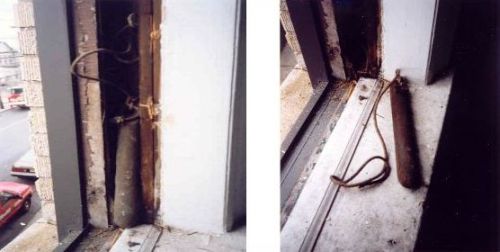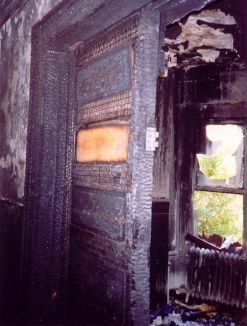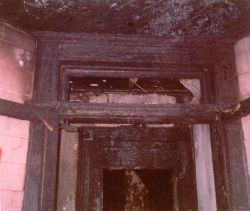Windows, Doors and More
As much time as we delegate in the fire service to reviewing and preparing for the challenges of light-weight constructed buildings, it is also important to go back and review some of the challenges found in older structures, especially if your area of responsibility has these type buildings in large number.
Many years ago as a young firefighter assigned to a Ladder Company 12 in Jersey City, I can remember an older seasoned firefighter who took me under his wing telling me that after a room or floor is burned out in an older frame or brick building, that it was important to pull and remove all the door and window trim in the apartment. “Great advice that we continue to pass on to our new firefighters today.” He would go on to state that the space between the rough opening and the window and door can vary as much as a 1/4 of an inch to a few inches, depending upon a number of factors that affected the installation at that time. This area where the plaster and lath of the wall ends and the door or the window begins, is only protected by the trimmed wood covering. If the wood trim is compromised in any way, or if the trim covering has a significant charring, fire can burrow into and behind the furred out spaces around the door and window openings. If fire, or a significant amount of heat is allowed into this space, most notably to the backside of the plaster and lath covering, it will allow fire to spread behind the window and door enclosures and into the building’s void spaces. At the very least he said, you have to anticipate that any compromising of these same areas can allow a fire to smolder for hours and eventually spread; therefore “open it up.”
While advising me of the above concern, he also spoke of two other overlooked areas within old frame and brick structures, those being window ballast pockets and the possible presence of sliding pocket doors.
Window ballast pockets: Window ballast pockets can be found in old double-hung wooden sash window enclosures. If an older window is still in use, a clue of a window ballast pocket will come from the presence of a rope or chain lining the inside of the window’s track. Pieces of rope or chain were often fastened to cast iron weights that were hidden within pockets on the sides of the window frame. This tubular shaped piece of cast iron was designed to slide up and down within the pocket to counter the weight of the window’s slide, allowing the window to stay open. The cast iron weight averages around 2″ in diameter, 10″ in length, and can weigh as much as five pounds. Its design allows it to ride up and down in the vertical channel or pocket for the entire height of the window. In many older buildings, renovations have replaced the older wooden window sashes with newer and smaller replacement windows. Replacement windows are often installed within the same opening as the older window leaving the original voids or pockets still in place. For ease and speed with the new window installation, window installers will cut the rope or chain attached to the older wooden sash window allowing

the ballast weight to fall and remain in the original pocket. This allowed the older wooden sash window to simply be removed making room for the new and smaller window to be installed within the existing opening. But as new and solid as the new window replacement will appear, if fire compromises any of the new decorative wood trim that wraps around it, the original void space will allow fire to travel in and behind the structure’s walls.
Sliding pocket doors: Sliding pocket doors were incorporated into an apartment or home to give privacy between rooms. The doors are often large in size and designed to be pulled from within the wall opening. The interior wall that houses the pocket  or opening is a wider framed wall than the other walls within the building allowing for the entire sliding door to disappear within. As firefighters, two immediate concerns must come to mind; first, if the doors are still in use today, the fire has early and easy access into the sliding door’s opening or pocket. Second is the width of the pocket door wall. This is a much wider wall that is not only designed to house a sliding pocket door, but is also a large opening into the building’s structure. This opening could easily allow fire to gain access to the building’s void spaces.
or opening is a wider framed wall than the other walls within the building allowing for the entire sliding door to disappear within. As firefighters, two immediate concerns must come to mind; first, if the doors are still in use today, the fire has early and easy access into the sliding door’s opening or pocket. Second is the width of the pocket door wall. This is a much wider wall that is not only designed to house a sliding pocket door, but is also a large opening into the building’s structure. This opening could easily allow fire to gain access to the building’s void spaces.
Because of their aesthetic value, many pocket doors are still in use today. For those that are no longer in use, you have to expect that may they have had their openings trimmed over. This may delay fire from extending in and behind the walls, but again if fire compromises the wooden trim, fire can extend to the building’s void spaces.
Transoms: Transoms are small windows designed and incorporated above a door or window opening. Their original intent was to allow light and possibly air into a room. They can often be found in older frame dwellings, schools, row frames, multiple dwellings and brownstones to name the more common. You can also find them in newer and modern homes and offices due to their aesthetic value and appearance.
In many older installations, homeowners may have restored their use and appearance to add to the home’s decor. But as decorative as some may appear,  they present a significant concern to firefighting forces. With older transom designs, all that prevented fire from penetrating the opening was a single pane of glass. Also in older designs, transoms openings were mounted on hinges to allow airflow. Opening and closing of the transom was/is done by pulling on a chord or decorative chain. If left open, or if the hinge mechanism failed or was damaged, smoke and eventually fire would penetrate the opening sooner.
they present a significant concern to firefighting forces. With older transom designs, all that prevented fire from penetrating the opening was a single pane of glass. Also in older designs, transoms openings were mounted on hinges to allow airflow. Opening and closing of the transom was/is done by pulling on a chord or decorative chain. If left open, or if the hinge mechanism failed or was damaged, smoke and eventually fire would penetrate the opening sooner.
What caused a great concern to fire fighters years ago and still to some degree today was a transom opening installed over an apartment door in a multiple dwelling. As fire spread throughout an apartment in a multiple dwelling, the single pane glass in the transom would quickly fail allowing fire and smoke into the public hallway. Over the years, city fire codes required the openings to be covered by plywood or sheetrock/gypsum. But as more years past, those coverings can become compromised presenting the same dangers of years ago. My mentor from Ladder Co.12 advised me to take a quick look at the condition of the transom openings on the fire floor, especially when we were assigned to search the floor above the fire. He advised me that “if they fail before the engine company has water on the fire, the staircase will become compromised requiring us to have additional means of egress sought out, so lets be prepared.” Sound advice that I still pass on today.
As we continue to share information and educate our members, it is important that the information sharing include the old as well as the new.
Stay Safe!
Michael Terpak
Deputy Chief-Jersey City
JCFD
This article is written in memory of Firefighter Frank Salerno
Ladder Co. 12 – Jersey City
